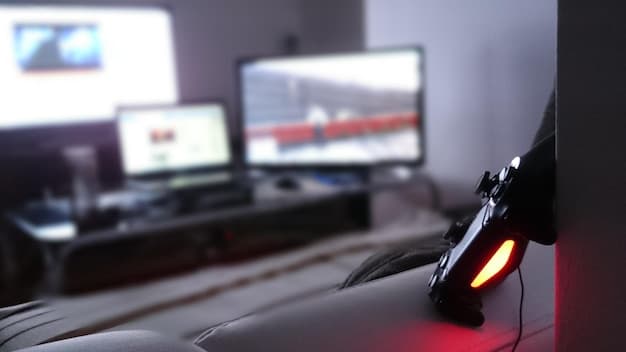Future of Gaming Monitors: 360Hz Refresh Rates & Beyond

The future of gaming monitors is rapidly evolving, with 360Hz refresh rates setting a new benchmark for competitive gaming and continued advancements in display technology promising even higher refresh rates, enhanced resolutions, and superior panel responsiveness to deliver unparalleled visual fluidity.
The landscape of interactive entertainment is ever-changing, and at its core lies the visual experience. As games become more graphically intensive and competitive play demands split-second reactions, the monitor’s role escalates. The journey toward unparalleled visual fidelity brings us to a pivotal point: The Future of Gaming Monitors: 360Hz Refresh Rates and Beyond. This isn’t just about faster screens; it’s about redefining immersion and competitive edge.
The Quest for Speed: Understanding High Refresh Rates
The refresh rate, measured in Hertz (Hz), dictates how many times a monitor updates its image per second. For decades, 60Hz was the standard, sufficient for general computing and casual gaming. However, as competitive gaming grew more sophisticated, players demanded smoother visuals and reduced input lag. This quest for speed led to the rapid adoption of 120Hz, then 144Hz, 240Hz, and now, the cutting-edge 360Hz. Each jump represents a palpable improvement in motion clarity, giving players an edge in fast-paced genres like first-person shooters (FPS) and racing games.
The human eye’s ability to perceive these differences has long been debated, but empirical evidence from professional gamers and scientific studies consistently shows a tangible benefit. Higher refresh rates reduce motion blur, make enemy movement more discernible, and significantly lower system latency, allowing for quicker reaction times. This isn’t merely a luxury; for those competing at the highest levels, it’s a fundamental performance enhancer. The transition from 144Hz to 240Hz was noticeable, but the leap to 360Hz pushes the boundaries even further, particularly in scenarios where every millisecond counts. This relentless pursuit of speed fuels the innovation driving monitor technology forward, as manufacturers strive to deliver the ultimate competitive advantage.
From 60Hz to 360Hz: A Brief Evolution
The journey from standard refresh rates to today’s ultra-high speeds has been swift. Early gaming monitors focused on resolution, but competitive play illuminated the need for speed.
- Early 2000s: 60Hz/75Hz LCDs become common, replacing bulky CRTs.
- Mid-2010s: 120Hz/144Hz monitors gain traction among enthusiasts.
- Late 2010s: 240Hz becomes the benchmark for professional eSports.
- Early 2020s: 360Hz emerges, targeting elite competitive players.
This rapid evolution underscores the gaming community’s insatiable demand for performance. Each increment, no matter how small, contributes to an overall smoother, more responsive experience. The integration of adaptive sync technologies like NVIDIA G-SYNC and AMD FreeSync further enhances this by eliminating screen tearing and stuttering, synchronizing the monitor’s refresh rate with the GPU’s frame rate. This symbiotic relationship between high refresh rates and adaptive sync has been crucial in perfecting the visual output, making every frame count.
The current 360Hz displays are primarily designed for eSports professionals and serious competitors who can extract every last bit of performance. They typically feature smaller screens (24 or 25 inches) and 1080p resolution to maximize frame rates and maintain competitive integrity. While enthusiasts might appreciate the smoothness, the jump from 240Hz to 360Hz is arguably less transformative than previous leaps, primarily benefiting individuals at the pinnacle of skill. However, the technology developed for these ultra-high refresh rate displays often trickles down to more mainstream models, improving the overall quality of gaming monitors across the board. The advancements in panel technology, such as faster response times and improved color accuracy, are also direct beneficiaries of this high-refresh-rate frontier.
The Technical Marvels Behind 360Hz Displays
Achieving a 360Hz refresh rate is no small feat; it demands a confluence of advanced display technologies working in harmony. The panel itself must be capable of changing the state of its pixels at an incredibly rapid pace. This is where technologies like Fast IPS (in-plane switching) and TN (twisted nematic) panels come into play, specifically engineered for quick response times. Fast IPS offers a good balance of speed and color accuracy, while TN traditionally excels in raw speed but falls short on viewing angles and color fidelity.
Moreover, the internal processing power of the monitor needs to be robust enough to handle the immense data flow required for 360 frames per second. This involves sophisticated scaler chips and optimized firmware that can process and output frames without introducing noticeable latency. The circuitry must be meticulously designed to maintain signal integrity at such high frequencies. Furthermore, the interface connecting the monitor to the graphics card, typically DisplayPort 1.4 or HDMI 2.1, must possess sufficient bandwidth to transmit the massive amounts of video data generated by a 360Hz signal. Without these critical components performing optimally, the promise of 360Hz would remain unfulfilled.

Panel Technologies Enabling Hyper-Responsiveness
The core of any high-refresh-rate monitor is its panel technology. For 360Hz, specific advancements are critical.
TN (Twisted Nematic) Panels: The Speed Kings
Traditionally the go-to for competitive gaming due to their lightning-fast response times.
- Pros: Extremely low response times (often 1ms or less), cost-effective.
- Cons: Limited viewing angles, poorer color reproduction compared to IPS.
TN panels continue to be a viable option for players who prioritize raw speed above all else, especially in environments where viewing angles are not a concern (e.g., sitting directly in front of the screen).
IPS (In-Plane Switching) Panels: Balancing Speed and Visuals
Once considered too slow for competitive gaming, IPS technology has made significant strides, leading to “Fast IPS” variants.
- Pros: Excellent color accuracy, wide viewing angles, much improved response times (often 1ms GtG).
- Cons: Generally more expensive than TN, still slightly slower than the fastest TNs.
Fast IPS panels have revolutionized the high-refresh-rate market, offering a compelling blend of speed and stunning visual quality. This allows gamers to enjoy both competitive performance and immersive graphics without significant compromise. The development of new liquid crystal formulations and optimized pixel structures has been key to achieving these speeds.
The future might also see Mini LED and OLED technologies entering the high-refresh-rate space, bringing with them unparalleled contrast and black levels. While OLED is already making inroads in desktop monitors, its high cost and potential for burn-in remain considerations. Mini LED, a backlight technology for LCD panels, offers much finer control over brightness and contrast, approaching OLED-like performance with less risk. These technologies, though currently focused on other aspects like HDR, will eventually push the boundaries of refresh rates even further, potentially enabling thousands of hertz in the distant future. The pursuit of faster response times isn’t just about refresh rates; it’s also about minimizing ghosting and overshoot artifacts, which can detract from motion clarity even on high Hz displays. Manufacturers are continuously refining pixel overdrive circuits and display algorithms to ensure that every frame is rendered as cleanly as possible.
Beyond 360Hz: What Lies Ahead?
While 360Hz is the current pinnacle for commercially available gaming monitors, the industry is already looking ahead. The pursuit of higher refresh rates isn’t linear; it involves overcoming significant technical hurdles related to panel response times, bandwidth limitations, and ultimately, the practical benefits for human perception. Research and development labs are exploring technologies that could push refresh rates into the 480Hz, 540Hz, and even 1000Hz realm. These advancements will likely come from further refinements in existing panel technologies, such as improved liquid crystal materials for LCDs, or potentially breakthrough technologies like microLED displays that offer virtually instant pixel response.
The challenge isn’t just creating a panel that can update that quickly, but also ensuring that graphics cards can consistently output such high frame rates, and that the display interface (like DisplayPort or future iterations) can handle the astronomical data throughput. We are entering a phase where the law of diminishing returns becomes more apparent for refresh rates. The jump from 60Hz to 144Hz was transformative; 144Hz to 240Hz was significant; 240Hz to 360Hz is subtle for most users. Beyond 360Hz, the visible difference might only be discernible to the most attuned eyes and in the most extreme, perfectly optimized competitive scenarios. However, the theoretical benefits of reduced system latency, even if imperceptible visually, could still provide a marginal competitive advantage.
Emerging Technologies and Their Potential
The path to refresh rates beyond 360Hz will be paved by cutting-edge innovations.
- MicroLED: Offers individual pixel control, superior contrast, and potentially instantaneous response times. Still prohibitively expensive for consumer monitors.
- Advanced Liquid Crystals: New materials and structures to speed up LCD pixel transitions even further, leading to 480Hz or 540Hz IPS panels.
- Optimized Display Pipelines: Reducing latency between GPU and monitor, enhancing end-to-end responsiveness regardless of raw refresh rate.
The focus will broaden from just “Hz” to the total “system latency” — the time it takes from a mouse click to an on-screen action. This holistic approach ensures that every component is optimized for speed, not just the monitor itself. The development of increasingly powerful graphics processing units (GPUs) and CPUs will also be crucial, as these components need to render games at frame rates matching or exceeding the monitor’s capabilities. A 540Hz monitor is only useful if the game can run at 540 frames per second.
Furthermore, artificial intelligence (AI) and machine learning (ML) could play a role in optimizing game rendering and display pipelines for ultra-high frame rates, predicting frames or enhancing motion clarity in ways traditional rendering cannot. While a 1000Hz monitor might seem like a distant dream, the underlying technologies that emerge from this pursuit will undoubtedly benefit all tiers of gaming displays, pushing the boundaries of what is visually possible. The ultimate goal is a seamless, real-time connection between player input and on-screen action, making the display feel like a window into the game world, rather than a separate device.
The Practicality and Limitations of Ultra-High Refresh Rates
While the allure of ultra-high refresh rates is strong, their practical benefits and limitations warrant careful consideration. For the vast majority of gamers, a 144Hz or 240Hz monitor already provides an excellent, fluid experience. The incremental gains from 240Hz to 360Hz are often subtle and primarily noticeable in specific, high-speed competitive scenarios by players with finely tuned perceptions. A casual gamer playing a graphically intensive single-player title might not even be able to run the game at frame rates high enough to fully utilize a 360Hz display, making the investment less impactful.
One significant limitation is the need for an immensely powerful gaming PC. To consistently hit 360 frames per second (FPS) or more, especially in demanding eSports titles, requires top-tier CPUs and GPUs. This adds considerably to the overall cost of a high-refresh-rate setup. Furthermore, ultra-high refresh rate monitors often come with a premium price tag, making them a niche product for serious competitors. As refresh rates climb higher, the data bandwidth requirements also escalate, potentially necessitating new cable standards and display interfaces. Gamers also need to consider resolution; typically, the highest refresh rates are paired with 1080p resolution to maximize frame rates. Moving to 1440p or 4K with such high refresh rates is even more demanding on hardware.
Who Truly Benefits from 360Hz+?
Not every gamer needs or will perceive the benefits of extreme refresh rates.
- Professional eSports Players: Every millisecond of reduced latency and motion clarity can make a difference in tournaments.
- Hardcore Competitive Gamers: Players dedicated to ranking high in fast-paced online games like CS:GO, Valorant, or Overwatch.
- Frame Rate Enthusiasts: Those who prioritize the absolute smoothest visual experience above all else, often with high-end PCs.
For casual gamers or those who enjoy visually stunning single-player experiences, investing in a monitor with a slightly lower refresh rate (e.g., 144Hz or 240Hz) but higher resolution (1440p or 4K) often provides a more balanced and enjoyable experience. The trade-off between refresh rate, resolution, and panel type becomes a crucial decision based on individual gaming habits and budget. The market is increasingly segmenting to cater to these different priorities, from ultra-fast competitive displays to high-resolution, high-fidelity immersive monitors. The future likely holds a continued diversification of monitor offerings, ensuring that every type of gamer can find a display tailored to their specific needs without overspending on features they won’t fully utilize. It’s about finding the right balance for one’s personal gaming ecosystem.
The Interplay with GPU Technology and Game Optimization
The performance of a gaming monitor, especially one boasting ultra-high refresh rates, is inextricably linked to the capabilities of the graphics processing unit (GPU) and the optimization of the games themselves. A 360Hz monitor is only as good as the frame rate your GPU can consistently deliver. If your graphics card can only output 150 FPS in a particular game, then the 360Hz refresh rate remains largely unutilized. This creates a fascinating dance between hardware innovation: monitors push the boundaries of display, while GPUs strive to render enough frames to match.
Leading GPU manufacturers like NVIDIA and AMD are continuously developing more powerful graphics cards capable of handling the immense computational load required for competitive gaming at high frame rates. Technologies like DLSS (Deep Learning Super Sampling) from NVIDIA and FSR (FidelityFX Super Resolution) from AMD use AI-powered upscaling to boost frame rates without a significant loss in image quality, making it more achievable for GPUs to reach and sustain ultra-high FPS targets. This synergy is crucial for unlocking the full potential of 360Hz and beyond monitors. Without these GPU advancements, ultra-high refresh rate displays would be mere theoretical benchmarks rather than practical tools for competitive advantage.
Optimizing for the Edge: Software and Hardware Synergy
Achieving peak performance with high-refresh-rate monitors requires a holistic approach, encompassing software, hardware, and configuration.
Driver and System Optimization
Maintaining up-to-date GPU drivers is paramount, as they often contain performance enhancements and bug fixes tailored for specific games and hardware. Operating system settings, such as power plans and game modes, can also be configured to prioritize gaming performance. Eliminating background processes and ensuring your system is running lean are also essential steps.
Game-Specific Settings
Game developers play a vital role too. Optimizing game engines for high frame rates and providing granular graphics settings allow players to tailor their experience. Many competitive eSports titles are designed to be performant on a wide range of hardware, making 360Hz more accessible. Reducing graphical fidelity in competitive games is often a trade-off many professional players make to ensure consistent high frame rates. This includes lowering texture quality, anti-aliasing, shadow details, and enabling performance-oriented rendering modes.
The constant feedback loop between game developers, GPU manufacturers, and monitor producers drives innovation across the entire gaming ecosystem. As one component pushes its limits, the others respond, leading to a continuous cycle of improvement. For instance, the demand for 360Hz monitors encouraged NVIDIA to further refine its G-SYNC technology for ultra-low latency. Similarly, the availability of such monitors impacts how game developers approach performance optimization for their titles, especially in the competitive arena. The goal is to minimize every possible millisecond of latency, from mouse click to pixel response, creating the most direct connection between player and game. This holistic approach ensures that the investment in a top-tier monitor is truly leveraged by the entire system, providing a real, tangible advantage to the player.

User Experience vs. Raw Performance: A Balancing Act
The discussion around “The Future of Gaming Monitors: 360Hz Refresh Rates and Beyond” inevitably leads to the core question of user experience versus raw performance. While high refresh rates offer undeniable competitive advantages, they are just one aspect of a complete gaming experience. For many, stunning visuals, vibrant colors, deep blacks, and higher resolutions contribute significantly more to immersion and enjoyment than the marginal competitive gain from 360Hz over, say, 240Hz.
The market currently balances these priorities. You have monitors designed for pure eSports performance (high refresh, low resolution, fast panels) and monitors designed for immersive, cinematic experiences (lower refresh, higher resolution, often OLED or Mini LED, excellent HDR). The trend suggests that these two paths will continue to diverge, though some technologies will undoubtedly cross over. The “ideal” monitor is highly subjective and depends entirely on a player’s primary use case. A professional streamer might prioritize a balance of high refresh rates for competitive play and excellent visual fidelity for content creation and audience engagement.
Factors Beyond Refresh Rate
A truly great gaming monitor offers more than just speed.
- Resolution: From 1080p to 4K and beyond, resolution dictates visual sharpness. Higher resolutions require more GPU power but create a more detailed image.
- Panel Type: TN, IPS, VA, OLED, Mini LED each offer different strengths in color accuracy, viewing angles, contrast, and response times.
- Color Accuracy and HDR: For visually rich games, wide color gamuts and High Dynamic Range (HDR) support dramatically enhance immersion.
- Response Time: Measured in milliseconds (ms), this indicates how quickly pixels can change color. Lower is better to reduce ghosting. Often conflated with refresh rate but distinct.
- Adaptive Sync (G-SYNC/FreeSync): Essential for tear-free gaming by synchronizing the monitor’s refresh rate with the GPU’s output.
As technology advances, we might see a convergence where ultra-high refresh rates become possible on high-resolution, HDR-capable displays without significant compromises. However, this will likely require significant breakthroughs in pixel technology and display interfaces. For now, gamers must weigh their priorities: is it raw speed for competitive dominance, or a rich, immersive visual journey? The future of gaming monitors will be defined not just by how fast they go, but by how well they balance all these critical factors to cater to the diverse needs of the global gaming community. The perfect monitor isn’t a one-size-fits-all solution; it’s a personalized choice that reflects individual play styles and preferences. The continued innovation in display technology ensures that gamers will have increasingly sophisticated options to choose from, refining their play and immersion in equal measure.
| Key Aspect | Brief Description |
|---|---|
| ⚡️ Refresh Rates | 360Hz is current peak, future aims for 480Hz+ for competitive edge. |
| 🚀 Panel Tech | Fast IPS and TN lead; MicroLED/OLED potential for future speeds. |
| 💻 GPU Synergy | High FPS from powerful GPUs and optimization (DLSS/FSR) are essential. |
| ⚖️ User Experience | Balancing speed, resolution, color, and features for diverse gamer needs. |
Frequently Asked Questions
▼
While 360Hz offers the absolute smoothest visuals and lowest latency, the noticeable difference compared to 240Hz is subtle for most. It’s primarily perceived by professional eSports players and hardcore competitive gamers who rely on every millisecond of advantage in fast-paced titles. Casual gamers might find the impact less significant.
▼
Absolutely. To take full advantage of a 360Hz monitor, your PC needs to consistently output 360 frames per second (FPS) or more in your desired games. This typically requires a top-tier CPU and the latest high-end graphics card (GPU). Without a powerful system, the monitor’s high refresh rate capability will be underutilized.
▼
High refresh rates like 360Hz are achieved through advancements in panel technologies such as Fast IPS and TN, which boast exceptionally fast pixel response times. Sophisticated internal monitor processing, sufficient bandwidth via DisplayPort 1.4 or HDMI 2.1, and robust internal circuitry are also critical components to handle and transmit the immense data flow.
▼
A primary trade-off is often resolution, as 360Hz monitors usually come in 1080p to maximize frame rates and reduce GPU strain. They also command a premium price and typically prioritize raw speed over features like superior color accuracy (compared to some professional creative displays) or deep blacks (like OLEDs). It’s a specialized tool for competitive advantage.
▼
Research is ongoing into technologies like 480Hz, 540Hz, and potentially even 1000Hz. This involves further refinements in liquid crystal materials, advancements in MicroLED technology for ultra-fast pixel response, and optimizations in the entire display pipeline from GPU to screen. The focus is shifting towards minimizing overall system latency for an even more direct player-game connection.
Conclusion
The journey of gaming monitor technology, from the venerable 60Hz standard to revolutionary 360Hz refresh rates and the tantalizing promise of even faster displays, reflects an unyielding pursuit of performance and immersion. While 360Hz currently represents the zenith for competitive players, offering an undeniable edge in fast-paced environments, the industry continues to innovate. The future promises not only higher refresh rates, but also a more seamless integration with powerful GPUs, AI-driven optimizations, and a nuanced balance between raw speed and breathtaking visual fidelity. As technology evolves, gamers will undoubtedly benefit from increasingly specialized and sophisticated displays, tailored to every need and desire, pushing the boundaries of what is possible in the digital realm. The ultimate goal remains a flawless, real-time connection between player and virtual world, making every movement, every reaction, instantaneous.





